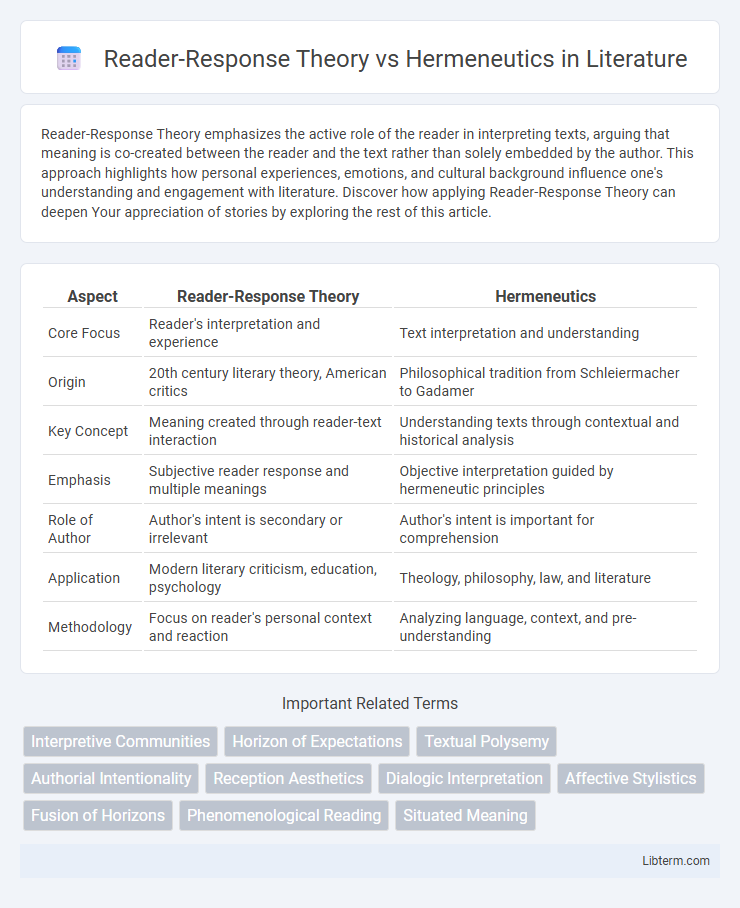Reader-Response Theory emphasizes the active role of the reader in interpreting texts, arguing that meaning is co-created between the reader and the text rather than solely embedded by the author. This approach highlights how personal experiences, emotions, and cultural background influence one's understanding and engagement with literature. Discover how applying Reader-Response Theory can deepen Your appreciation of stories by exploring the rest of this article.
Table of Comparison
| Aspect | Reader-Response Theory | Hermeneutics |
|---|---|---|
| Core Focus | Reader's interpretation and experience | Text interpretation and understanding |
| Origin | 20th century literary theory, American critics | Philosophical tradition from Schleiermacher to Gadamer |
| Key Concept | Meaning created through reader-text interaction | Understanding texts through contextual and historical analysis |
| Emphasis | Subjective reader response and multiple meanings | Objective interpretation guided by hermeneutic principles |
| Role of Author | Author's intent is secondary or irrelevant | Author's intent is important for comprehension |
| Application | Modern literary criticism, education, psychology | Theology, philosophy, law, and literature |
| Methodology | Focus on reader's personal context and reaction | Analyzing language, context, and pre-understanding |
Introduction to Reader-Response Theory and Hermeneutics
Reader-Response Theory emphasizes the reader's role in interpreting texts, suggesting meaning emerges through individual experience and personal engagement with the text. Hermeneutics, rooted in philosophical tradition, focuses on the systematic exploration of textual meaning through historical context, author intent, and linguistic structures. Both theories prioritize interpretation but diverge in their approach: Reader-Response values subjective interpretation, while Hermeneutics seeks objective understanding through scholarly analysis.
Historical Background and Development
Reader-Response Theory emerged in the 1960s as a reaction against New Criticism, emphasizing the reader's role in creating meaning by interpreting texts through personal experience and cultural context. Hermeneutics, with roots tracing back to ancient philosophy and theological exegesis, evolved particularly in the 19th and 20th centuries through scholars like Friedrich Schleiermacher and Hans-Georg Gadamer, focusing on understanding texts through historical context and the fusion of horizons between author and reader. Both approaches have significantly influenced modern literary criticism by shifting the focus from fixed meanings to dynamic interpretation processes grounded in reader interaction and historical consciousness.
Core Principles of Reader-Response Theory
Reader-Response Theory centers on the reader's role in interpreting texts, emphasizing that meaning is created through the reader's individual experiences and emotions rather than being fixed in the text itself. This approach highlights the variability of interpretations, asserting that each reading is unique and influenced by the reader's cultural and personal context. Unlike Hermeneutics, which seeks objective understanding through historical and linguistic analysis, Reader-Response Theory prioritizes subjective engagement and the interactive process between text and reader.
Foundational Concepts in Hermeneutics
Hermeneutics centers on the foundational concept of interpreting texts by uncovering the intended meaning through historical context, authorial intent, and linguistic structures. Unlike Reader-Response Theory, which emphasizes the reader's subjective experience and individual interpretation, hermeneutics seeks objectivity and a systematic approach to understanding texts. Key principles include the hermeneutic circle, where interpretation involves a continuous interplay between the part and the whole of the text to achieve deeper comprehension.
Roles of the Reader: Engagement and Interpretation
Reader-Response Theory emphasizes the active role of the reader in constructing meaning, highlighting personal engagement and subjective interpretation as central to textual understanding. Hermeneutics, by contrast, involves a structured interpretative process grounded in historical context and authorial intent, guiding readers toward uncovering inherent meanings within the text. While Reader-Response prioritizes individual experience, Hermeneutics focuses on methodical analysis, balancing reader engagement with disciplined interpretation.
The Text’s Authority: Fixed Meaning vs. Interpretive Flexibility
Reader-Response Theory challenges the concept of a fixed meaning by emphasizing the reader's role in constructing the text's significance, highlighting interpretive flexibility and personal engagement with the narrative. Hermeneutics, rooted in philosophical tradition, asserts the text's authority through historical context and authorial intent, seeking a more stable and objective understanding. The tension between these approaches centers on whether meaning resides inherently within the text or is dynamically created through interaction with the reader.
Subjectivity and Objectivity in Literary Analysis
Reader-Response Theory emphasizes subjectivity by highlighting the reader's role in interpreting texts, where meaning varies based on individual experiences and emotions. Hermeneutics seeks objectivity through a systematic approach to uncovering the author's intended meaning and cultural context, aiming for a more universal interpretation. Balancing these perspectives enriches literary analysis by accounting for both personal engagement and structured understanding.
Influential Thinkers and Key Works
Reader-Response Theory, championed by Stanley Fish and Louise Rosenblatt, emphasizes the reader's role in creating meaning, with key works including Fish's "Is There a Text in This Class?" and Rosenblatt's "The Reader, the Text, the Poem." Hermeneutics, rooted in the works of Friedrich Schleiermacher and Hans-Georg Gadamer, focuses on interpreting texts within historical and cultural contexts, exemplified by Gadamer's "Truth and Method" and Schleiermacher's foundational lectures on hermeneutics. Both theories shape literary analysis by contrasting the dynamic reader's input with the structured interpretive framework of the text.
Strengths and Criticisms of Each Approach
Reader-Response Theory emphasizes the active role of the reader in creating meaning, highlighting subjective interpretation and diverse perspectives as its strengths; however, it faces criticism for potentially neglecting the author's intent and the text's inherent structure. Hermeneutics prioritizes the historical context and author's intention, providing a systematic approach to understanding texts, yet it may be criticized for being overly rigid and dismissive of individual reader experiences. Both approaches contribute valuable insights but may benefit from integration to balance subjective and objective elements in literary analysis.
Contemporary Relevance and Applications
Reader-Response Theory emphasizes the active role of the reader in creating textual meaning, making it highly relevant in contemporary digital media where diverse interpretations proliferate. Hermeneutics, grounded in philosophical traditions, remains crucial for interpreting complex legal, religious, and literary texts, offering structured methods to uncover intended meanings. Both frameworks enhance understanding by accounting for context, reader perspective, and text, influencing modern education, media studies, and interdisciplinary research.
Reader-Response Theory Infographic

 libterm.com
libterm.com